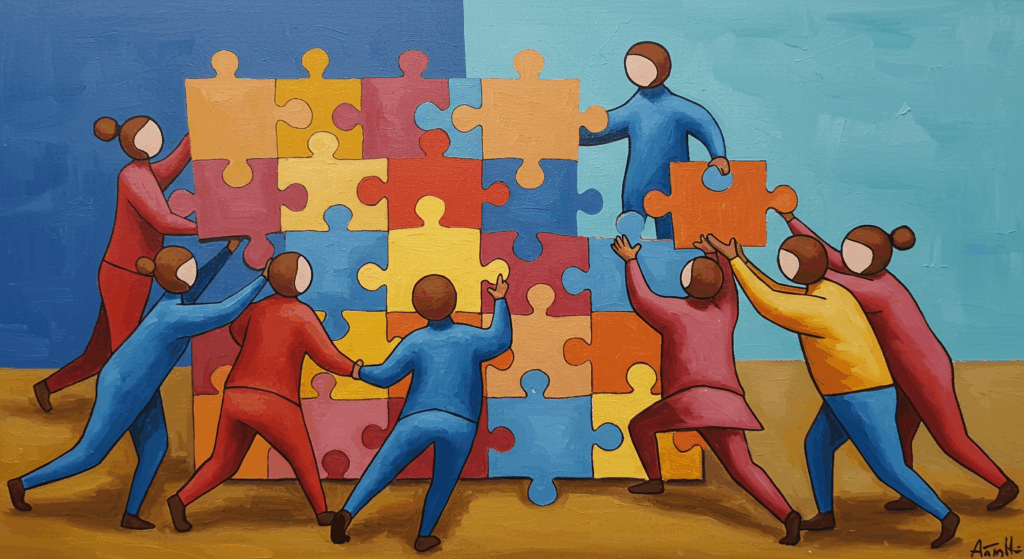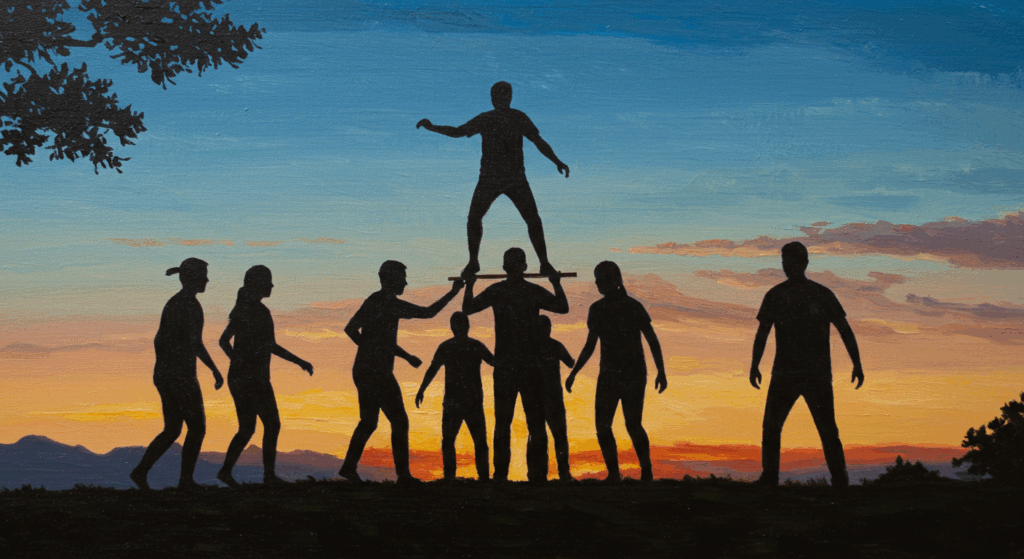Let’s be real: a lot of “team building” is… cringe. You know the vibe—forced trust falls, awkward icebreakers where someone overshares about their pet iguana, and a facilitator who keeps saying, “Okay, let’s circle back.” Hard pass. But here’s the good news: team development activities don’t have to be that. When you do them right, they actually help people work together (hi, teamwork), level up their craft (hello, skills enhancement), and actually want to show up (yes, engagement). And ngl, that combo is kinda the dream.
If you’ve ever thought, “There has to be a better way,” you’re in the right place. Grab a coffee (or a chaotic energy drink), because we’re going to talk about team development that’s practical, fun, and intentionally human—like a well-curated Spotify playlist where every song hits.
What “Team Development Activities” Actually Mean (Without the Corporate Buzzword Salad)
Think of team development activities as the structured moments that help your group become more than a Slack channel. They’re not just games, and they’re not only for offsites. They’re the micro-habits and shared experiences that make teamwork easier, faster, and more joyful.
At their best, these activities:
- Build trust and psychological safety (people feel okay to speak up).
- Create shared language and mental models (fewer “Wait, what are we even doing?” moments).
- Drive skills enhancement through peer learning and experiments.
- Increase engagement by making work feel meaningful, social, and kinda fun.
Also: team development ≠ one-time event. It’s not “We did an offsite once, so we”re good.” It’s more like going to the gym—steady reps beat heroic workouts. (Sorry, but also yay, because small wins are sustainable.)
The Big Three: Teamwork, Skills Enhancement, Engagement (And Why They’re Connected)
Here’s the triangle you can draw on a napkin:
- Teamwork: how well we coordinate, communicate, and deliver together.
- Skills enhancement: how we keep learning individually and as a group.
- Engagement: how much people care and feel energized by the work.
Do activities for one leg, and the others usually get a glow-up. Teach people something new (skills), they collaborate better (teamwork), and suddenly they’re more into it (engagement). It’s like layering sunscreen, moisturizer, and vibes. Each helps the others look good.
Quick Compass: How To Choose the Right Activity (So It Doesn’t Flop)
Before you pick anything, answer three things:
- Outcome: What do you actually want? More cross-team collaboration? Faster decisions? Stronger feedback culture?
- Constraints: Time, budget, and people (remote/hybrid/in-person). Accessibility needs too—always.
- Energy: What’s the current team mood? Burnt out? Stretched? New folks? Choose activities that add energy, not drain it.
A tiny rule of thumb: pick the lowest-effort activity that still moves the needle. “Small but consistent” beats “big and rare” every time.
The Starter Pack: Easy Wins You Can Run This Week
These are light-lift, low cringe, high impact. Most take 15–45 minutes.
1) The One-Slide Team Charter
Goal: alignment + agency.
How: Each person answers:
- What I do best / want to do more of
- What I need to do my best work
- “This is how to work with me” (communication preferences, no-meeting blocks)
Compile into one slide per person. Share and reference it in onboarding.
Why it works: Boosts engagement (people feel seen) and teamwork (fewer misunderstandings).
2) Lightning Demos (15 minutes)
Goal: skills enhancement.
How: One person teaches a tiny trick—keyboard shortcuts, a spreadsheet formula, a Figma hack, a sales objection line. 5 minutes explain, 5 minutes demo, 5 minutes Q&A.
Why it works: Everyone learns fast. Zero prep beyond “show us the thing.”
3) Retro with Emojis
Goal: debrief honestly.
How: In a shared doc, everyone drops three emojis:
- 😄: what sparked joy
- 😬: what felt off
- 💡: one improvement
Group similar ones, pick 1–2 actions.
Why it works: Psychological safety without long speeches.
4) Coffee Roulette (Remote-Friendly)
Goal: connection.
How: Pair people randomly for 20 minutes each month. Give them three starter prompts (see below).
Why it works: Cross-pollinates ideas and reduces “silo vibes.”
5) Kudos Ring
Goal: recognition ritual.
How: End weekly standup by giving one shout-out to a teammate for something specific. 60 seconds max.
Why it works: FAST cycle of appreciation → better engagement.
Prompts you can steal for Coffee Roulette:
- What’s a recent “tiny win” you’re proud of?
- What’s your favorite “I cannot live without this” work shortcut?
- What’s a hobby you picked up that surprised you?
Activities by Theme (Pick and Mix)
Teamwork Boosters That Don’t Feel Cheesy
- Mission Map: On a virtual whiteboard, draw the big goal. Add sticky notes for who contributes what, and where dependencies exist. Connect them. You’ll spot bottlenecks instantly.
- Decision Journal: For any big call, track: the options, the criteria, the decision owner, the date, and the why. Review monthly to learn your patterns.
- Meeting Makeover: Try a 30-day experiment: agendas sent 24 hours early, clear “who decides,” a timekeeper, and a 3-minute “what did we decide?” wrap. It’s shockingly good.
Skills Enhancement (Peer-Learning, But Make It Fun)
- Skill Swap Fridays (30 minutes): Two people teach one micro-skill each. Rotate weekly.
- Shadow Days: Marketers sit with support, PMs sit with sales, engineers with QA. One hour. Each person writes 3 insights + 1 change they’ll try.
- Demo Day: Once a month, showcase work-in-progress. Celebrate ugly prototypes. “Ship the messy” culture accelerates learning.
- Book Bite, Not Book Club: Instead of a whole book, one person summarizes a chapter or a podcast episode + one activity to try.
Engagement That’s Real (Not Just Pizza)
- Impact Stories: Start all-hands with a 3-minute customer or user story that shows how the team’s work actually helped someone. Feels good, fuels purpose.
- Autonomy Menu: Collect the decisions people can make without approval. Expand it. The fastest engagement boost you can buy is trust.
- Growth Bingo: A fun grid with items like “taught a skill,” “asked for feedback,” “shipped a small experiment,” “paired with someone in a different role.” Small prizes for bingoooo.
Communication & Feedback (minus the awkward)
- Start/Stop/Continue Round: One minute per person: what should we start doing, stop doing, and continue doing? Timebox tightly.
- Feedback Speed-Dating: 5 minutes per pair, two questions: “What should I do more of?” “What could I try differently?” Rotate twice.
- Clarity Clinic: Bring a confusing doc or process. The group asks only clarifying questions for 10 minutes. Then propose improvements.
Trust & Safety (Because Vulnerability ≠ Oversharing)
- Failure Museum: Everyone shares a past flop and what it taught them. Keep it respectful and normalizing.
- Red Team Drill: Once a quarter, pick a plan and ask a “red team” to poke holes kindly. Gratitude required.
- Boundaries Charter: As a group, list working hours norms, DM rules, and how to signal “deep work.” Better boundaries = calmer brains.
Creativity & Problem-Solving (Get Unstuck Fast)
- Constraints Challenge: “How might we increase adoption with $0 marketing?” or “Design a feature that works with no UI text.” Constraints force creative oxygen.
- Crazy 8s: Everyone sketches eight ideas in eight minutes. Vote, mash up, pick one to test.
- Reverse Brainstorm: Instead of solving the problem, brainstorm how to make it worse. Then flip each idea into a prevention tactic. Slightly evil, highly effective.
Hybrid & Remote-Friendly Formats
- Async Brainstorm Doc: 24 hours for ideas in silence. Upvotes with reactions. Then meet only to choose.
- Show-and-Tell Slack Thread: Weekly prompt, “What did you ship?” or “What did you learn?” Encourages momentum.
- Meme Monday: It’s silly, but honestly—humor glues teams together. Keep it kind, keep it PG-ish.
A Few Signature Activities (With Steps You Can Literally Copy)
“Mission → Metrics → Moves” Workshop (60–90 minutes)
Use when: the team’s busy, but not aligned.
Outcome: clarity on goals and the next 2–3 moves.
- Mission (10 min): In one sentence, what are we actually trying to do this quarter? Write three versions; pick one.
- Metrics (15 min): Choose 2–3 indicators that prove we’re moving (not 12 KPIs… pls no).
- Moves (30–45 min): Brainstorm actions. Vote on the top three using impact/effort. Assign owners + dates.
- Make it stick (5 min): Write the decision in a shared doc. Review weekly for 5 minutes.
Why it rocks: It’s the fastest path from “we should” to “we did.”
“Skill Swap Studio” (45 minutes)
Use when: you want quick skills enhancement and momentum.
Outcome: two micro-skills learned + demoed.
- Two volunteers pick a micro-skill (e.g., “how to wrrite a tight PRD” or “cold outreach line that gets replies”).
- Each teaches for 10 minutes with a tiny practice exercise.
- Group writes a one-liner: “Try this when ___.”
- Post both lessons in a shared doc for quick reference.
Pro tip: Don’t overproduce. Real is better than polished.
“Tiny Test Lab” (2 weeks)
Use when: you need progress but everything feels stuck.
Outcome: three tiny experiments and learnings.
- Define a hypothesis (“If we add X, Y will improve”).
- Pick three ideas you can test in 1–3 days each.
- Assign owners; timebox.
- Share results in a 15-minute demo. Decide: scale, tweak, or kill.
Why it works: It’s addicting to ship. Engagement tends to spike when people see forward motion.
Make It Inclusive (Because One-Size-Fits-No-One)
A few guidelines to keep activities safe, accessible, and genuinely welcoming:
- Zero forced vulnerability. Offer “pass” options.
- Cameras optional. Give equal footing for chat participation.
- Accessible formats. Captions, readable colors, wheelchair-friendly spaces, dietary needs, prayer breaks—bake it in.
- Rotating facilitation. Let different voices lead.
- Global-friendly timing. Rotate meeting times or run async versions for different time zones.
Big picture: inclusion isn’t an add-on; it’s the engine of better teamwork and richer skills enhancement.
How to Measure What Matters (Without Becoming a Spreadsheet Zombie)
You don’t need a giant dashboard, but a few signals help:
- Pulse Check (monthly, 3 questions):
- I feel comfortable speaking up in this team.
- I’m learning and growing here (skills enhancement).
- I feel energized by our work (engagement).
1–5 scale, plus one free-text question: “What’s one small thing that would improve our teamwork next month?”
- Velocity of Decisions: Are we deciding faster? If your “Decision Journal” logs go from 3 a month to 8, that’s a vibe.
- Experiment Throughput: How many tiny tests did we run this quarter? Did at least one become a new norm?
- Onboarding Speed: How long until a new person ships something? Team development done well shrinks that ramp.
- Recognition Ratio: Aim for at least one kudos per person per month. It sounds fluffy; it’s not.
A 30-60-90 Plan (So This Doesn’t Stay Aspirational)
1. Days 1–30: Foundations
- Run One-Slide Team Charter and Retro with Emojis.
- Start a Decision Journal doc.
- Start Lightning Demos weekly (15 minutes at the end of standup).
- Schedule Coffee Roulette.
2. Days 31–60: Momentum
- Host a Mission → Metrics → Moves workshop.
- Run a Tiny Test Lab (two-week cycle).
- Add Kudos Ring to the end of weekly meetings.
- Share an Impact Story at all-hands.
3. Days 61–90: Scale & Sustain
- Rotate facilitation to new folks (hello engagement + growth).
- Run a Demo Day for WIP.
- Launch Autonomy Menu v1 (what people can decide solo).
- Do a Pulse Check and adjust next quarter’s plan.
If that feels like a lot, start with the one that feels easiest this week. Tiny wins compound.
Manager, IC, HR? Here’s Your Move
- If you’re a manager: Protect time for learning. Publicly model curiosity. Say “I don’t know” out loud. Create those autonomy menus.
- If you’re an IC: Pitch one activity you can run yourself (Lightning Demo, Retro, Coffee Roulette). Your initiative is the culture.
- If you’re HR/People Ops: Equip teams with templates, toolkits, and calendared rituals. Don’t own it all; empower leaders to run their own micro-programs.
Fixing Common Pitfalls (Because They Happen)
- “We’re too busy.” Try 10-minute rituals (Kudos Ring, Retro Emojis). Time expands for what works.
- “This feels cheesy.” Involve the team in choosing activities. Use the words “experiment” and “opt-in.”
- “No one speaks up.” Start with async prompts; invite written responses first. Use small breakout rooms.
- “It’s always the same people leading.” Create a facilitation rota with micro-roles: opener, timekeeper, note-taker, closer.
- “We forget the follow-up.” End every activity with one action, one owner, one date. Put it in your Decision Journal.
Micro-Activities You Can Drop Into Any Meeting (Steal These)
- Status Haiku (1 minute each): “This week I’m focused on __ / Blocking issue is __ / I’ll need help with __.” Weirdly therapeutic.
- Rose / Thorn / Bud: What’s good (rose), what’s tricky (thorn), what’s a possibility (bud).
- One-Word Check-In: Everyone shares one word for their current energy. Fast scan of team mood.
- If This Were TikTok: “What’s the hook of our project in 10 seconds?” Forces clarity and fun.
Offsite Ideas That Don’t Involve Falling Backwards
- Community Service Sprint: Half-day volunteering. Bonding plus impact? chef’s kiss.
- Cooking Challenge: Teams cook the same dish with constraints (five ingredients, 40 minutes). Judge on taste + collaboration.
- Creative Lab: Provide craft supplies or LEGO sets. Build “the future version of our product/team” and present it.
- Low-Ropes-Style Simulations: If you want physical activities, keep it accessible and focus on strategy, not athleticism.
Templates You Can Copy
Weekly Team Rhythm (60 minutes total)
- 10 min wins + kudos
- 15 min Lightning Demo
- 15 min decisions + blockers
- 15 min plan the next tiny tests
- 5 min “what did we decide?”
Retro Skeleton (30 minutes)
- 5 min silent brain dump (😄 😬 💡)
- 10 min cluster + vote
- 10 min choose two actions (owner + date)
- 5 min appreciation round
Skill Swap Rotation
- Week 1: Product + Support
- Week 2: Sales + Marketing
- Week 3: Eng + QA
- Week 4: Any cross-pair you haven’t tried
A Note on Culture: Make Learning the Default
Teams that win long-term have a habit: they learn in public. They celebrate drafts, not just releases. Normalize questions. They run experiments. And they treat feedback like WD-40—just a spritz and everything moves better.
If you want teamwork to be smooth, skills enhancement to be constant, and engagement to stay high, build a culture where tinkering is praised, not punished. Where people get credit for surfacing problems early. Where “I have a weird idea” is a welcome sentence.
FAQs People Don’t Ask Out Loud (But Think About)
Do we really need activities? Can’t we just… work?
You can, but it’s slower, messier, and people burn out. Activities are the scaffolding that help work happen better.
How often should we do this?
Weekly tiny rituals, monthly deeper sessions, quarterly offsites or strategy resets. And yes, you can flex it.
What if the team is skeptical?
Start with opt-in, low-effort activities that create value quickly (Lightning Demos, Tiny Tests). Then invite feedback. You don’t have to “sell” good practices; results do the selling.
What if our team is remote and across time zones?
Lean into async: Google Docs brainstorms, recorded 5-minute demos, Slack threads for kudos. Use time-boxed meetings for decisions and connection.
Sample 6-Week Program (Copy, Paste, Adjust)
- Week 1: One-Slide Team Charter + Kudos Ring
- Week 2: Lightning Demo + Retro with Emojis
- Week 3: Mission → Metrics → Moves workshop
- Week 4: Tiny Test Lab kickoff (pick 3 experiments)
- Week 5: Coffee Roulette + Demo Day (WIP only)
- Week 6: Pulse Check + Autonomy Menu v1 + Celebration
If it helps, label this an “experiment.” People relax when it’s not “forever.”
Final Pep Talk (Because You’ve Got This)
Look, you don’t need a giant budget, a TED-Talk facilitator, or a cabin in the woods to build a strong team. You need intentional moments that fuel teamwork, create steady skills enhancement, and keep engagement alive when the deadlines stack up. Start small. Celebrate often. Document decisions. Run tiny tests. And keep it human—slightly messy, a little funny, and very real.
If you try one thing this week, make it a 15-minute Lightning Demo or a Retro with Emojis. See how the energy shifts. Then build from there.
You’ve got this—now go pick one activity, put it on the calendar, and invite your team. Future-you (and honestly, your whole crew) will be grateful.









